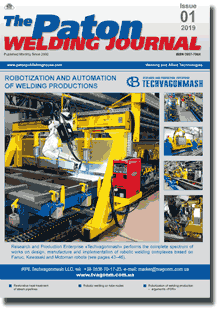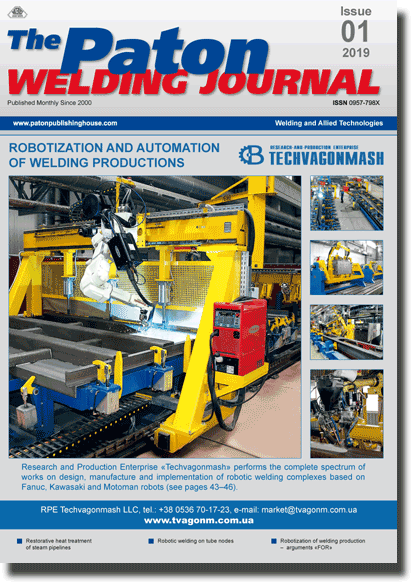| 2019 №01 (02) |
DOI of Article 10.15407/tpwj2019.01.03 |
2019 №01 (04) |

The Paton Welding Journal, 2019, #1, 10-14 pages
Journal The Paton Welding Journal
Publisher International Association «Welding»
ISSN 0957-798X (print)
Issue #1, 2019 (February)
Pages 10-14
Strength and fatigue life of joints of high-strength alloy AA7056-T351, made by electron beam welding
I.N. Klochkov, V.M. Nesterenkov, E.N. Berdnikova and S.I. Motrunich
E.O. Paton Electric Welding Institute of the NAS of Ukraine 11 Kazimir Malevich Str., 03150, Kyiv, Ukraine. E-mail: office@paton.kiev.ua
Application of modern aluminium alloys when designing elements and structures for aircraft and rocket construction, sea vessels and ground transportation, is ensured by high values of their strength and ductility. New welding technologies allow reducing the structure weight and lowering the operating costs, respectively, while providing the required values of strength and fatigue life. Here, producing sound welded joints of heat-hardenable aluminium alloys is an urgent science and technology problem. Application of welding technologies with a small temperature contribution, such as electron beam welding, compared to traditional welding processes, is promising for aircraft and rocket construction. The objective of this work is studying the level of softening, structural features, magnitude of residual postweld stresses, mechanical properties and regularities of fatigue resistance of joints of heat-hardenable aluminium alloy AA7056-T351 with higher zinc content, produced by electron beam welding. 8 Ref., 2 Tables, 5 Figures.
Keywords: welded joints, fatigue resistance, residual stresses, aluminium alloy, electron beam welding
Received: 04.10.18
Published: 13.02.19
References
1. Ishchenko, A.Ya. (2003) Aluminium high-strength alloys for welded structures. Progresyvni Materialy i Tekhnologii, 1, 50–82 [in Russian].
2. Gureeva, M.A., Grushko, O.E., Ovchinnikov, V.V. (2008) Welded aluminium alloys in structures of transport vehicles. VIAM/2008-205182, 10, 51–82 [in Russian].
3. Fridlyander, I.N., Sandler, V.G., Grushko, O.E., Bersenov, V.V. et al. (2002) Aluminium alloys as a perspective material in automobile industry. Metallovedenie i Termich. Obrab. Metallov, 9, 3–9 [in Russian].
4. Martin, K., Ruzek, R., Novakova, L. (2015) Mechanical bahaviour of AA7475 friction stir welds with the kissing bond defect. Int. J. of Fatigue, 74(5), 7–19.
5. Eibla, M., Sonsinob, C.M., Kaufmann, H., Zhanga, G. (2003) Fatigue assessment of laser welded thin sheet aluminium. Ibid., 25(8), 719–731. https://doi.org/10.1016/S0142-1123(03)00053-7
6. Nesterenkov, V.M., Kravchuk, L.A., Arkhangelsky, Yu.A., Orsa, Yu.V. (2017) Formation of welded joints of magnesium alloys in pulse multipass electron beam welding. The Paton Welding J., 4, 35–38. https://doi.org/10.15407/tpwj2017.04.07
7. Kasatkin, B.S., Kudrin, A.B., Lobanov, L.M. et al. (1981) Experimental methods of investigation of strains and stresses. Kiev, Naukova Dumka [in Russian].
8. Gushcha, O.I., Smilenko, V.N., Kot, V.G., Brodovoj, V.A., Klochkov, I.N. (2009) Control of stresses based on application of subsurface acoustic waves. Tekh. Diagnost. i Nerazrush. Kontrol, 1, 11–13
Suggested Citation
I.N. Klochkov, V.M. Nesterenkov, E.N. Berdnikova and S.I. Motrunich (2019) Strength and fatigue life of joints of high-strength alloy AA7056-T351, made by electron beam welding. The Paton Welding J., 01, 10-14.The cost of subscription/purchase order journals or individual articles
| Journal/Currency | Annual Set | 1 issue printed |
1 issue |
one article |
| TPWJ/USD | 384 $ | 32 $ | 26 $ | 13 $ |
| TPWJ/EUR | 348 € | 29 € | 24 € | 12 € |
| TPWJ/UAH | 7200 UAH | 600 UAH | 600 UAH | 280 UAH |
| AS/UAH | 1800 UAH | 300 UAH | 300 UAH | 150 UAH |
| AS/USD | 192 $ | 32 $ | 26 $ | 13 $ |
| AS/EUR | 180 € | 30 € | 25 € | 12 € |
| SEM/UAH | 1200 UAH | 300 UAH | 300 UAH | 150 UAH |
| SEM/USD | 128 $ | 32 $ | 26 $ | 13 $ |
| SEM/EUR | 120 € | 30 € | 25 € | 12 € |
| TDNK/UAH | 1200 UAH | 300 UAH | 300 UAH | 150 UAH |
| TDNK/USD | 128 $ | 32 $ | 26 $ | 13 $ |
| TDNK/EUR | 120 € | 30 € | 25 € | 15 € |
AS = «Automatic Welding» - 6 issues per year;
TPWJ = «PATON WELDING JOURNAL» - 12 issues per year;
SEM = «Electrometallurgy Today» - 4 issues per year;
TDNK = «Technical Diagnostics and Non-Destructive Testing» - 4 issues per year.


